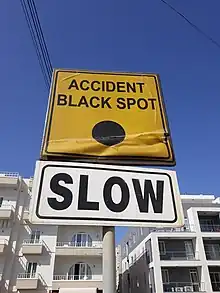Accident blackspot
In road safety management, an accident blackspot or black spot is a place where road traffic collisions have historically been concentrated. It may have occurred for a variety of reasons, such as a sharp drop or corner in a straight road, so oncoming traffic is concealed, a hidden junction on a fast road, poor or concealed warning signs at a crossroads.


For some decades treatment of accident blackspots (e.g. by signage, speed restrictions, improving sightlines, straightening bends, or speed cameras) was a mainstay of road safety policy, but current thinking has it that the benefits of these interventions are often overstated. Effects such as regression to the mean,[1] risk compensation[2] and accident migration combine to reduce the overall benefit.
In 1973, Edward Douglas-Scott-Montagu, 3rd Baron Montagu of Beaulieu said in a debate in the House of Lords:[3]
One of the most ridiculous signs in this country is the "black spot" accident sign. If anything, this sign is a terrible reflection on the attitude of the road authorities. Accidents are caused by bad road design, and not by drivers looking for accidents. I hope that, as a result of this Bill, we shall see that rather ridiculous sign removed from British roads.
In some cases it has been claimed that the end result of such interventions in accident blackspot areas is an increase in overall casualties. In one notable experiment, a number of accident blackspots were "treated" with a null treatment—placement of a garden gnome, according to some reports. Crash rates at these points were found to have decreased significantly in the following period, a finding which is taken as clear evidence supporting the theory of regression to the mean.
See also
References
- UCL and PA Consulting Group for Department for Transport UK national safety camera programme - Four-year evaluation report December 2005 Archived November 22, 2008, at the Wayback Machine Appendix H describes the effects of RTM
- Jackson JSH, Blackman R (1994). "A driving-simulator test of Wilde's risk homeostasis theory" (Document). Journal of Applied Psychology.
- "Road Traffic Bill Hl". 1973-11-15. Retrieved 2022-06-13.